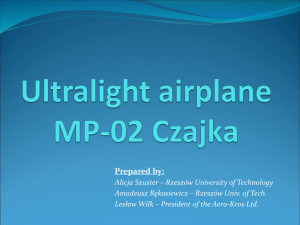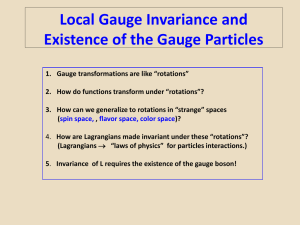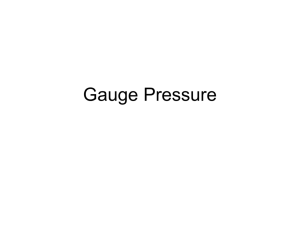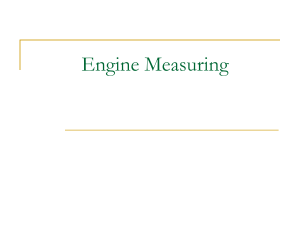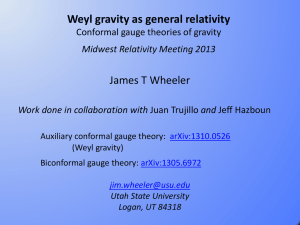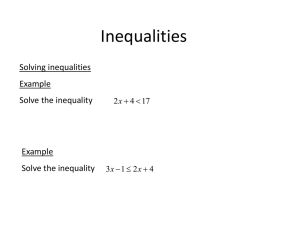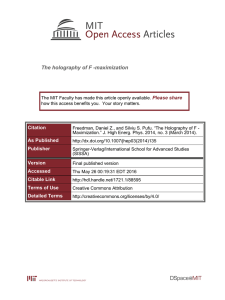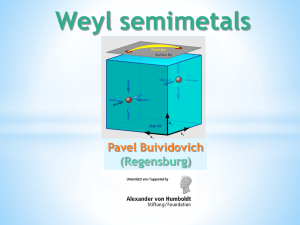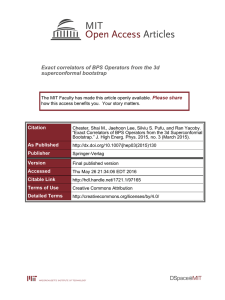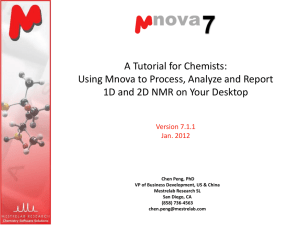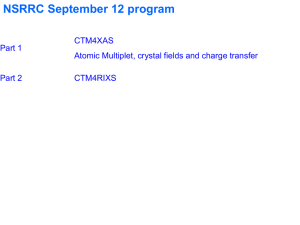Antoine Van Proeyen
advertisement
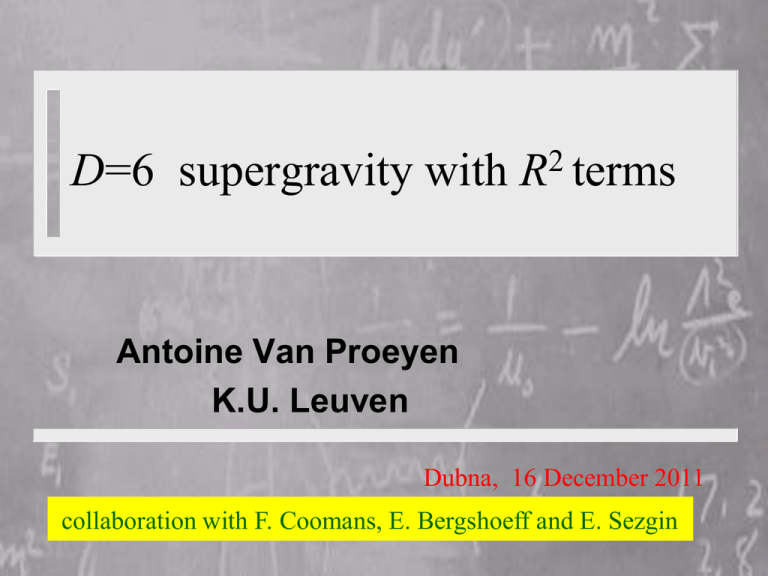
D=6 supergravity with R2 terms
Antoine Van Proeyen
K.U. Leuven
Dubna, 16 December 2011
collaboration with F. Coomans, E. Bergshoeff and E. Sezgin
The map: dimensions and
# of supersymmetries
D susy
11 M
32
24
20
16
12
8
4
M
10 MW IIA IIB
I
9 M
N=2
N=1
8 M
N=2
N=1
7 S
N=4
N=2
6 SW
(2,2)
(2,1)
5 S
N=8
N=6
4 M
N=8
N=6
(1,1)
(2,0)
(1,0)
N=4
N=5
N=4
N=2
N=3
N=2
N=1
Plan
1.
2.
3.
4.
5.
D=6 supersymmetry: what is special ?
Higher derivative actions
Construction of actions (main part)
Solutions
Conclusions and outlook
1. D=6 supersymmetry
Spinors are symplectic – Weyl, therefore
sometimes called ‘chiral supergravity’
Minimal algebra has 8 generators: like N=2
R-symmetry is USp(2)=SU(2)
2-forms have dual formulation,
4-forms are like scalars
There is an off-shell and superconformal
formulation
Symplectic-Weyl spinors
spinors have 8 components for D=6
Conventions: metric mostly +,
hermitian ° ¹ for ¹ spacelike directions, anti-hermitian °0
Projections
Weyl spinor is projected spinor
or
‘Reality’ for spinors is defined by a ‘charge conjugation’:
¸C ´ i °0 C-1 ¸ *
Majorana spinors are ‘real’: ¸C=¸ but for D=6: (¸C)C= - ¸
unavoidable for consistency with Lorentz symmetry
Therefore symplectic Majorana:
consistently combined with Weyl condition:
symplectic-Weyl spinor: doublet of 4 –component spinors
with reality condition → 8 real components
Symmetry properties
Also different symmetry properties:
therefore we define
such that
R-symmetry
Transformations between supersymmetry
parameters:
preserving symplectic structure
is group USp(2) = SU(2)
p-form gauge fields
they are all gauge fields:
Reducible symmetry
Degrees of freedom:
off-shell: as antisymmetric tensor in SO(D-1), i.e. SO(5)
(massive representation)
on-shell: as antisymmetric tensor in SO(D-2), i.e. SO(4)
(massless representation)
•
Duality: p-form ↔ (D-2-p)=(4-p) form: because field
strength are related by Hodge duality
On- and off- shell degrees of
freedom
off-shell degrees of freedom :
# of field components − # gauge transformations
(are SO(D-1) representations)
On-shell= # of helicity states
or count # initial conditions and divide by 2. E.g. -scalar:
field equation ¹¹Á =0.
Initial conditions Á(t=0,xi) and 0Á(t=0,xi)
- fermions: eom linear in derivative:
½ of components
(are SO(D-2) representations)
12.3 Multiplets
There is an argument that
# bosonic d.o.f. = # fermionic d.o.f.,
based on {Q,Q}=P (invertible)
Q
Should be valid for on-shell multiplets if eqs. of
motion are satisfied
for off-shell multiplets counting all components:
2. Higher derivative actions
Why interested in higher-derivative terms
methods: perturbative or not
Interest in higher-derivative terms
appear as ®0 terms in effective action of
string theory
corrections to black hole entropy
higher order to AdS/CFT correspondence
compactification to D=3 : make graviton a
(massive) propagating mode (graviton not
prop. without higher-derivative terms)
Bergshoeff, Hohm, Rosseel, Sezgin, Townsend, 1005.3952
Perturbative or ‘toy model’
(1) perturbative as in string theory: supersymmetric only order by
order in ®0
(2) off-shell exactly supersymmetric invariants have been
constructed
then ‘auxiliary fields’ are propagating.
In method (2): ghosts.
If we put small parameter before invariants, then auxiliary fields
can be eliminated perturbatively
Open question: is this on-shell Lagrangian related to
compactified string Lagrangian (which has no auxiliary fields)
We will consider (2) with arbitrary (not necessarily small)
parameter , ‘toy model’.
3. Construction of actions
The off-shell super-Poincaré action using
superconformal methods
Coupling to vector multiplets and gauging
the R-symmetry
Alternative off-shell formulation
R2 invariant
total action
Constructions of actions
Possible constructions:
order by order Noether transformations: the only
possibility for the maximal theories (Q>16)
superspace:
- very useful for rigid N=1: shows structure of multiplets.
- very difficult for supergravity. Needs many fields and many
gauge transformations
(super)group manifold:
- Optimal use of the symmetries using constraints on the
curvatures
superconformal tensor calculus:
- keeps the structure of multiplets as in superspace but avoids
its immense number of unphysical degrees of freedom
- extra symmetry gives insight in the structure
- ! only for #Q · 16 (i.e.when there are matter multiplets)
For minimal supergravity D=6
Component, Noether procedure:
Nishino, Sezgin, 1984
Superspace:
Awada, Townsend, Sierra, 1985
Group manifold:
R. D'Auria, P. Fré, T. Regge, 1983: ‘Consistent
supergravity in six dimensions without action invariance’
Superconformal:
Bergshoeff, Sezgin and AVP, 1985;
F. Coomans and AVP, 1101.2403
Conformal gauge fields
Constraints determine
two gauge fields
‘Weyl multiplet’:
K-gauge choice:
remains dilatation as extra gauge symmetry
Gravity as a
conformal gauge theory
The strategy
• scalar field (compensator)
conformal gravity:
dilatational gauge fixing
First action is conformal invariant,
gauge-fixed one is Poincaré invariant.
Scalar field had scale transformation df (x)= ¸ D(x)f(x)
f
Schematic: Conformal
construction of gravity
conformal scalar action
(contains Weyl fields)
Gauge fix
dilatations and
special conformal transformations
Poincaré gravity action
Superconformal algebra
In general
D=6, N=2 superconformal gauge
multiplet
determined by
constraints
‘Weyl multiplet’:
remaining ‘extra’ symmetries: D, Ka, SU(2), Si
PS: there is also another choice of extra fields,
i.e. another Weyl multiplet,
but this one is chosen to obtain an invariant action
Compensating multiplet:
linear multiplet
gauge fix:
fixes D and SU(2) →SO(2)
fixes Si
fixes Ka
we also split the gauge field
SU(2) = traceless + SO(2)
The strategy
superconformal action of linear multiplet
(contains Weyl multiplet)
Gauge fix extra symmetries
Poincaré supergravity action
To obtain R- symmetry gauging
we add a vector multiplet
superconformal invariant action uses fields of Weyl multiplet
coupling with linear multiplet
Gauged supergravity
e.g.
U(1)R £ U(1) gauge symmetry
remainder from SU(2)
gauged by V¹ ; param. ¸
from gauge mult
gauged by W¹ ; param. ´
E¹º½¾ field equation: 4-form becomes scalar
fix Á = Á0 :
W¹ gauges R-symmetry
Alternative formulation
other gauge fixing
then: ¾ and Ãi replaced by L and i
The R¹ºab R¹ºab invariant
Trick from E.Bergshoeff, M. Rakowski, 1987:
Transformation laws equal with vector multiplet
Define
The R¹ºab
¹ºab
R
invariant
off-shell: every term is separately invariant.
No auxiliary fields eliminated yet:
U(1)R £ U(1) gauge symmetry
Final action
PS: not in Einstein frame.
L=1 gauge would have been in Einstein gauge.
For much of the analysis, the gauge ¾ =1 is easier
4. Solutions
Salam-Sezgin, 1984:
no 6D Minkowki or (A)dS solution, but
a Mink4 £ S2 preserving N=1 in D=4. (1/2 susy)
with higher derivatives:
without flux
- a 3 or 4-dimensional Minkowski or dS; non-susy
with flux
- 2-form flux with 4-dimensional Minkowski, dS or AdS
SS solution survives !
- 3-form flux for AdS3 × S3 solutions
Solutions and supersymmetry
Consider d(e) (boson) = e fermion
d(e) (fermion) = e boson
We consider solutions with fermions=0 !
(such that at least some Lorentz symmetry is preserved)
To check susy of a solution: just check
d(e) (fermion) = e boson = 0
This restricts e and the boson configuration.
d(e) (fermion) = 0 includes differential equation
for e(x) ! In general not any more e(x), but
spinors dependent on constants
Algebra reduces to a Lie algebra with global
supersymmetry
Solutions without flux
scalar L is a constant L0> 0, arbitrary
We find in general R=g2 L0 :
hence Mink6 can only be a solution for g=0.
For g 0: neither a solution for any constant curvature,
i.e. no (A)dS6
in g2 L0
Solutions M1£ M2, with e.g.
have fixed M2= mg2
all non-susy
Solutions with 2-form flux
Supersymmetric solution: Mink4 £ S2 preserving
N=1 in D=4. (1/2 susy)
with fluxes of gauge fields W and of V on the
sphere.
M2 not fixed !
other non-susy solutions with
-
Mink4 £ S2 and M2=-4g2
AdS4 £ S2
dS4 £ S2
dS4 £ H2
Solution with 3-form flux
M1£ M2 , both 3-dimensional
flux of B on both factors
g=0: no effect of higher-derivative terms;
AdS3 £ S3 susy solution
g 0: found one solution with M2 fixed:
AdS3 £ S3 non-susy solution
5. Conclusions and outlook
using off-shell formulation constructed Rsymmetry gauged minimal D=6 supergravity
with higher derivative terms
auxiliary fields can be eliminated perturbatively
potential is not modified by Riem2 terms
the supersymmetric Mink4 £ S2 solution is still
valid
other solutions exist
Outlook
D=6 is highest that allows an off-shell formulation:
worthwile to investigate further
adding Yang-Mills multiplets and hypermultiplets
anomalies (grav. CS term is part of the Riem2 invariant)
ghost problem
Weyl invariant exists ?
black hole solutions ?
- higher derivatives important for connection
microscopic – macroscopic entropy
- so far only Gibbons – Maeda
for ungauged and without higher derivative action.

